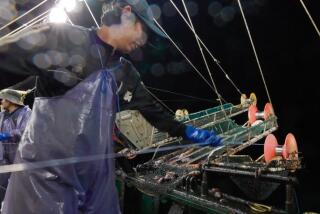Genetically engineered salmon is fit for dinner, FDA says in first decision of its kind
- Share via
Reporting from SEATTLE — Chinook. Sockeye. Coho. AquAdvantage.
Perhaps that last breed does not evoke images of ancient and frigid headwaters in Alaska or Arctic Canada, where wild salmon spawn every year, or even the humble hatcheries that produce less expensive species consumed by millions of people.
But on Thursday, the Food and Drug Administration announced that the AquAdvantage salmon — developed using growth hormone from Chinook salmon and a gene from an eel-like ocean fish that makes it reach market size twice as quickly as other salmon — has become the first genetically engineered animal approved for American consumption.
AquaBounty Technologies Inc., the Massachusetts company that created the fish, calls it “the world’s most sustainable salmon.” Opponents call it “Frankenfish.” The FDA, which was accused of delaying the decision for years amid public concern, now says you can call it dinner.
“The data demonstrated that the inserted genes remained stable over several generations of fish, that food from the GE salmon is safe to eat [for] humans and animals, that the genetic engineering is safe for the fish, and the salmon meets the sponsor’s claim about faster growth,” the FDA said Thursday.
Genetically modified versions of agricultural products including cotton, corn, soybeans, sugar beets, apples, squash, potatoes and papayas have been approved by the FDA over the last two decades.
The salmon decision was a long time coming — AquaBounty began developing its salmon in the 1990s — and it may do little to quiet a debate over genetically modified plants and animals that has been rising among consumers, grocers, scientists and industry.
Reaction on Thursday was quick and varied.
The Biotechnology Industry Organization praised the decision, saying “animal biotechnology can improve livestock to require less feed, produce more protein, and reduce environmental impact, while also providing for enhanced animal health and welfare.”
Some environmental groups attacked it, citing polls showing a majority of Americans are opposed to engineered salmon, and noting commitments by grocers including Whole Foods and Target not to sell it. The groups warn that genetically engineered fish could escape their farms, potentially putting at risk wild populations that already face serious threats from habitat loss, hydroelectric dams and climate change.
“GE salmon will do nothing to help habitat or otherwise address these problems, and depending on how GE salmon are produced, could represent a new threat to wild populations very much like salmon farms do currently,” said Joseph Bogaard, director of the Seattle-based Save Our Wild Salmon.
“Americans will be eating synthetic salmon, thinking they are receiving the nutritional benefits of wild salmon,” Pete Knutson, a member of the Puget Sound Salmon Commission, said in statement circulated by Friends of the Earth.
Some scientists expressed cautious approval, citing potential future food shortages, the fact that foods have been genetically altered to some degree over generations of agriculture, and the precautions AquaBounty has promised it will put in place.
At least one delegation of elected officials — those from Alaska, where salmon fishing is essential to the culture and economy — expressed loud and unified disapproval.
“I am livid at the FDA’s announcement to approve genetically engineered ‘salmon’ — what seems to be more science experiment than fish or food,” Republican U.S. Sen. Lisa Murkowski said.
Nodding to a debate that goes beyond salmon, Murkowski noted that she had introduced legislation that would require labeling the fish “to ensure that Americans know what they are consuming.”
See the most-read stories this hour >>
There currently are no federal laws that would require genetically engineered salmon or other food to be labeled, though there has been pressure for such a system, and stores including Whole Foods have begun establishing their own systems.
Along with its approval of the AquAdvantage salmon on Thursday, the FDA announced draft guidelines for a voluntary labeling system it said manufacturers could use to identify genetically modified foods.
Felicia Billingslea, director of FDA’s Division of Food Labeling and Standards, said in a written statement that the idea was to “make it easy for consumers to know whether a food was produced using genetic engineering or not.”
The salmon decision was a major victory for AquaBounty Technologies.
The company created the fish from an Atlantic salmon, adding growth hormone from Chinook salmon from the Pacific and a gene from a fish called an ocean pout to help it grow faster.
AquaBounty says it has made the fish infertile to alleviate concerns that they could interbreed with wild stocks. In addition, the company says the FDA “requires them to be grown in physically contained land-based systems, further reducing any potential impact on wild populations.”
For now, the fish is grown only in facilities in Panama and Canada, and it could be years before it is widely available to American consumers.
On its website — in addition to offering recipes for “Sesame Crusted Salmon with Roasted Pepper Salsa,” salmon burgers and other meals — AquaBounty quotes a food writer for the Toronto Star, Michele Henry, who wrote about eating AquAdvantage in 2014.
“The flesh is exquisite,” Henry wrote. “Buttery, light, juicy. Just as Atlantic salmon should be.”
Twitter: @yardleyLAT
ALSO
Victim finds cellphone thief’s selfie in her cloud storage, police say
Historic Taco Bell building to make ‘run for’ Irvine on the back of a truck
450 illegal tamales from Mexico seized at LAX and ‘incinerated’ (not steamed)
More to Read
Sign up for Essential California
The most important California stories and recommendations in your inbox every morning.
You may occasionally receive promotional content from the Los Angeles Times.











